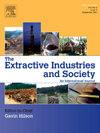矿区轮班工作模式与远距离通勤之间是否存在关系?来自智利采矿业的见解
IF 4.3
2区 社会学
Q2 ENVIRONMENTAL STUDIES
Extractive Industries and Society-An International Journal
Pub Date : 2025-04-21
DOI:10.1016/j.exis.2025.101670
引用次数: 0
摘要
最近,采矿业出现了延长轮班工作模式的趋势,但尚未分析这种趋势对采掘地区长途通勤(LDC)的影响。由于延长轮班时间减少了长途通勤者的出行次数并降低了交通成本,这种制度安排可以扩大长途通勤的地理范围。这一趋势在智利采矿业尤为明显,自 2000 年代初以来,智利的轮班工作模式显著增加。本文基于对智利安托法加斯塔地区近 2400 名长途通勤者的调查,以及国家补充收入调查(ESI)的二手数据,研究了轮班模式的扩展与长途通勤者的旅行距离和花费时间之间的关系。此外,文章还探讨了延长轮班工作模式对矿区的影响。我们的研究结果表明,轮班模式的延长与通勤距离的增加有关。劳动力市场的这种地理扩张导致矿业公司可获得更多的劳动力供应,从而对安托法加斯塔当地矿业工人的工资和就业机会产生负面影响。本文章由计算机程序翻译,如有差异,请以英文原文为准。
Is there a relationship between shift work patterns and long-distance commuting in mining regions? Insights from the Chilean mining industry
The recent trend of extending shift-work patterns in the mining industry has not been analyzed in terms of its consequences for long-distance commuting (LDC) in the regions where extraction occurs. As longer rosters decrease the number of trips and lower transport costs for long-distance commuters, this institutional arrangement can expand the geographical scope of LDC. This trend has been particularly evident in the Chilean mining industry, where shift-work patterns have significantly increased since the early 2000s. Based on a survey of nearly 2400 long-distance commuters to the Antofagasta region in Chile, as well as secondary data from the National Supplementary Income Survey (ESI), this article examines how the extension of shift patterns is related to the distance traveled and time spent by long-distance commuters. Furthermore, it explores the consequences of extended shift-work patterns for mining regions. Our results indicate that more extended shift patterns correlate with increased commuting distances. This geographical expansion of the labor market leads to a larger labor supply available for mining companies, negatively affecting wages and job opportunities for local mining workers in Antofagasta.
求助全文
通过发布文献求助,成功后即可免费获取论文全文。
去求助
来源期刊

Extractive Industries and Society-An International Journal
ENVIRONMENTAL STUDIES-
CiteScore
6.60
自引率
19.40%
发文量
135
 求助内容:
求助内容: 应助结果提醒方式:
应助结果提醒方式:


